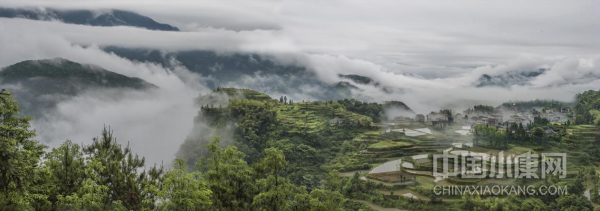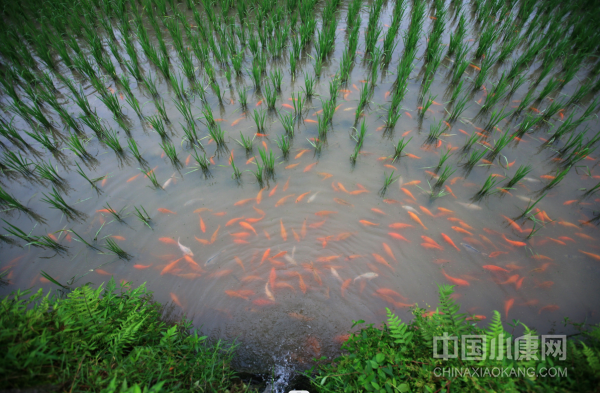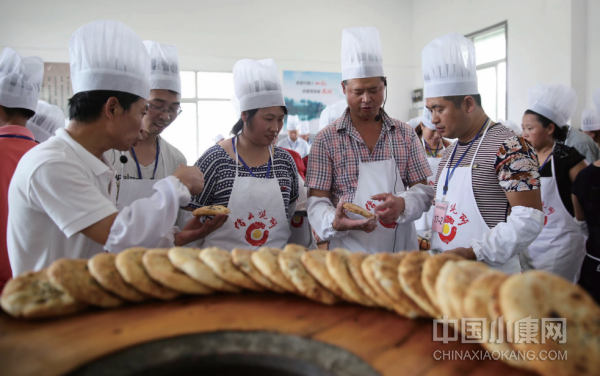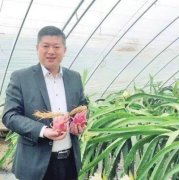解码丽水优质农业系列报告体制变革下的共享财
文章 《小康》记者周宇
2022年7月17日至19日,全球重要农业文化遗产大会将在丽水市青田县举行。 大会前夕,《小康》杂志系统梳理了丽水优质农业的亮点实践,深度解码背后的经验。
治国之道,始于富民。
“十四五”伊始,浙江被赋予高质量发展、建设共同富裕示范区的重任。 推动共同富裕,最艰巨、最艰巨的任务在农村。 农村发展不平衡不充分问题最为突出; 城乡差距和收入差距在农民中最为突出。

图:稻鱼共生——青田县小舟山乡天人合一的田园风光
丽水市位于浙江西南部,是一座典型的山地城市,具有“九山、半水、半田”的地貌。 当地农业占三大产业比重为6.8%,是浙江省平均水平3.3%的两倍多。 全市80%以上的面积是农村,近70%的人口是农民。 农业经济具有极高的影响力和社会关联性。 可以说,农业实力和农民富裕直接决定高质量发展和共同富裕示范区建设的质量。
近年来,丽水市委、市政府提出实施素质提升、组织发展、数字赋能“三化”战略,“全面推进乡村振兴,打造农业农村现代化山区样板”。以人类现代化为核心”的目标,把大力发展优质农业作为乡村振兴、共同富裕的重要手段,推动农业产业“做强”,进而实现农民“致富”。
什么是优质农业? 出发点是什么? 样本的意义是什么? 以问题为导向,《小康》系统解读丽水实践,希望为广大山区推动乡村振兴、实现高质量绿色发展提供有益借鉴。
解码——为何打造优质农业?
丽水优质农业的发展不是无源之水,而是基于对全球和全国农业发展趋势的分析判断。 这是目标导向、问题导向、需求导向下的必然选择。
丽水农业具有得天独厚的生态优势。 该市空气清新,水质洁净,植被茂盛,生物多样性特征明显。 森林覆盖率高达81.7%,居全国第二位。 全市工业污染物排放总量较小,污染负荷指数全省最低。 是全国首个“中国天然氧吧城市”,也是唯一一个水、空气环境质量双双跻身全国前十的地级市。 由于丽水山区地势起伏较大,受季风和地形影响,全年温暖湿润,雨量充沛,四季分明,无霜期长。 具有立体山地气候,横向区域差异和垂直差异明显。 但同时,丽水农业也面临山区农业的共性问题——耕地面积小、农业生产经营“小而散”。
如何利用优势弥补劣势? 早在2003年,浙江就提出并实施了发展“高效生态农业”战略,以绿色消费需求为导向,以农业产业化、经济生态理念为指导,以提高市场竞争力和可持续发展能力为核心,将进一步推动农业结构战略性调整。
此后,在“高效生态、特色优质农业”的新定位下,丽水也经历了以农业生产环境质量为重点的“生态优质农业”阶段(2013-2016年),以“农业”着眼于农业生产过程的质量。 “绿色发展”阶段(2017-2020年),再到当前整个农业体系质量的“品质农业”阶段(2021-),重点推进农业体系转型,以实现丽水的又一次升级农业。
丽水定义的“品质农业”,是以农产品优质安全为基础,以国际对标、产业化管理、组织化发展、标准化生产、全流程管控、数字赋能为抓手,打造现代科技与传统农业的结合。 需求侧和供给侧一体化的现代农业生产体系。 既能充分发挥山区农业发展的比较优势,克服自然劣势,又符合国家农业生产“三品一标”推进行动和浙江省优质高效的战略要求农业,也顺应了人们对优质农产品的消费需求趋势。
解码——如何打造品质农业?
如何系统推进优质农业工作? 丽水以“四品一标准一高”为突破起点,即辨识度品种培育、国际化质量控制管理、山字品牌打造、合规市场品味延伸,古今结合的标准化生产方式,以及以“三农名师”为核心的高素质农民培育,贯穿于农业生产环境、生产流程、产品创造、人才培养的整个体系,并取得了一系列标志性成果。
第一个产品:特色品种培训
农业是立国之本,种植业是基石。 种业是国家战略性、基础性、核心“芯片”产业,是保障国家粮食安全的基础。 丽水市种质资源丰富多样,气候垂直差异明显,生态环境优质。 完全有能力抢占“种子革命”的制高点。
目前,丽水已建立了粮食作物、蔬菜、水果、茶叶、中药材、食用菌等产业繁育基地或种质资源苗圃,为优质种质资源保护和优质农业快速发展奠定了基础。 。

图:国家水稻分子育种中心丽水示范基地
粮食作物方面,遂昌县拥有全省最大的籼型杂交水稻种子生产基地,年制种面积约1.2万亩,可生产优质杂交水稻种子近300万公斤; 莲都区拥有全国首个“国家水稻分子育种智能示范基地”——国家水稻分子育种中心丽水示范基地。蔬菜方面,龙泉市拥有省级良种繁育基地和两个低、中速集约化育苗厂。其高海拔苗木厂是目前浙江省海拔最高的蔬菜苗繁育基地;水果方面,云和县拥有全国首个云和雪梨种质资源圃,莲都区拥有全国最大的本地枇杷种质资源库经济作物方面,松阳县建成了浙江省首个大型茶树种质资源苗圃,收集国内外茶树种质资源2400余种,其中全国363种中药材丽水市分布有251种,占69.1%,是名副其实的“天然药材花园”。 目前有莲都老朱、滁州白莲和本润覆盆子、龙泉味真堂铁皮石斛、八都三叶青、青田树桥百合、浙江贝母、清远三和园华中楼、缙云双溪口米仁、遂昌石莲聚米、金竹三叶青、湖山青千柳、松阳大东坝凉茶、景宁延溪黄精种质资源园等。丽水还分布着360多种大型食用菌。 清远建成首个省级食用菌种质资源库。 龙泉、景宁分别建有食用菌育种基地,是省级农作物良种育种基地。
“十四五”期间,丽水将围绕食用菌、茶叶、粮油、蔬菜、水果、中药材、畜禽、水产、油茶九大主导产业建设100个良种基地油橄榄; 打造丽水特色现代种业企业,充分发挥主导产业种源优势,努力引进或培育一批现代种业企业。
第二个产品:对标国际质量控制管理
人们对于农产品能否安心吃最直接的感受就是化肥农药的使用情况。 因此,丽水把“化肥农药双控”作为提升农业质量、推动农业高质量发展的重要抓手。 它选择全球最严格的农药法规——欧盟农药法规作为对标对象,执行最严格的标准。 以最严格的准入标准、最严格的销售登记、最严格的使用管理、最严格的质量控制、最严格的惩戒措施,通过数字化应用场景,实现农药化肥从销售到使用的全市、全方位、全流程已初步实现。 精准智能控制。

图:化肥药品双控在线监管平台
2018年,丽水全市开展了为期三年的“对标欧盟、管化肥药品”行动。 2020年底,丽水“对标欧盟·化肥药品双控”工作被农业农村部专家组形容为“科学把握新发展阶段、新发展理念、新发展格局,全国农业质量转型迈出有力步伐。” 探索区域农产品全流程管控解决方案和农业高质量绿色发展最佳实践。”2021年,丽水再次升级,发布《丽水市“对标欧盟·双控新三年行动计划”》 《化肥药品管理办法(2021-2023年)》。如今,全市化肥、农药使用量较2017年分别下降11.3%、17.68%。
“对标欧盟、化肥农药双控”表面上是减少农药化肥的使用,但背后实际上面临着如何科学对标、如何长期监管、如何提供保障等新问题。农业科技支撑、如何实现农业治理能力现代化等,在国内并没有先例可循。 丽水探索的实践经验呈现出三大特点。
特点一:制度建设、机制建设是基础。 丽水市2018年实施“欧盟化肥药品双控”时,以“指标体系、任务体系、管理体系、责任体系、考核体系”为基础,进行了顶层设计肥料和药物控制》。 “双重控制”思维导图。 以科学对标为例,丽水构建了动态对标机制。 邀请专家和专业机构对我国批准登记使用的696种农药进行论证梳理,其中我国批准使用但在欧盟已撤销使用的农药共计158种。 综合评估,最终提出丽水市禁用限用农药105种(分四批实施),不建议禁用限用农药53种,计划更换农药目录中的112种农药。通过禁用和限用农药来满足农业生产的需要。
特点二:以5S农资店打造、数字化监管为抓手。 实施“欧盟化肥药品双控”,必须把控农资销售“源头”。 2021年,丽水市发布实施全国首个农资商店市级地方标准——《农资经营基本规范》(DB3311/T187-2021),规定了资质要求、经营场所、仓储地点、人员要求、管理要求等。所谓“5S”是指标准(Standard)、安全(Safety)、服务(Service)、节约(Saving)、卫生(Sanitation)。
在规范改造药店等农资门店的同时,数字化场景建设是长效监管的关键。 丽水建立了“欧盟化肥药品双控”全区域在线监管场景应用平台,实现农业投入品从“进口-销售-使用-退货”全周期闭环管理。 具体来说,是农业智慧大脑,三大触发入口(浙江省李办“i丽水”群众举报入口和12345投诉举报平台;省农产品质量安全监管和农业投入品信息智能预警入口)监管系统;综合执法日常检查、部门和行业监管日常检查门户)、五个信息数据库(禁限用农药和化肥清单、农业投入品经营主体、规模化农产品生产主体、监管标准文件)数据库、监管处置事件数据库)、六张专题图【规模化农产品生产主体专题图、农药禁限用专题图、农药化肥销售专题图(农资店)、农药专题图和化肥使用强度、全球农业执法网格专题图、事件预警处置专题图]、三大处置模式(一般事件、部门协调事件、农业执法事件)和生态信用体系建设。 这一数字化改革的应用,变“群众管理”为“干部管理”,变“人力管理”为“智慧管理”,变“分散管理”为“联合管理”,为区域农产品全程质量控制提供解决方案。
“化肥农药双控”的根本目的是让农产品质量更高、卖得更好、让农民受益。 丽水市推出“绿色农惠卡”信息管理服务平台,参照社保卡理念和管理模式,实行农药作为医疗药品实名销售、实名购买、实名报销。 农民正在购买政府指定的有机肥和复合肥。 购买农药、杀虫剂等农资时,凭惠农卡可享受10%以上折扣。
特点三:科技创新、绿色防控是关键。 “对标欧盟,化肥农药双控”的目的不是禁止和限制,而是倒逼生产方式转变,推动农业高质量绿色发展。 丽水提炼出通过农业科技创新实现绿色防控的十大模式,分别是:全球农业基因传承模式,如青田“稻鱼共生体系”; 智慧农业生产模式,如莲都气雾种植; 社会化组织服务型,如遂昌无人机“飞防”; 古代农耕生产类型,如松阳自然农场; 技术创新驱动型,如清远甜橘; 生态循环农业类型,如龙泉山区特色生态循环示范区; 品牌建设主导型,如丽水山农; “景宁600”产业等高山特色农业类型; 绿色防治技术类型,如缙云野生稻; 社会综合管理型,如云和学礼。
第三个产品:以“山”字为基础的品牌建设
好的品质还需要好的品牌的引导。 丽水在立体气候、生物多样性等方面具有独特的农业禀赋优势。 但当时丽水有大大小小的农业实体7000多家,各类农业品牌2800多个,难以在市场上形成真正的影响力和竞争力。 2014年,丽水率先推出覆盖全区域、全品类、全产业链的市级农产品区域公共品牌——丽水山耕。 同时,不断探索“丽水山农”生态有机农产品、“丽水山居”农家精品民宿、“丽水山景”乡村旅游、“丽水山景”乡村旅游、“丽水山居”等“山”品牌一体化发展路径。山泉”高端饮用水。

以“丽水山农”为例,丽水打造区域公共品牌的实践有三层含义。
启示一:在顶层设计方面,“三位一体”1+N模式。 区域公共品牌的打造需要系统的思考。 政府的决心、国有企业的承诺、民营企业的参与缺一不可。 “丽水山农”的组织架构是“政府引导、协会注册、国有公司运营”的“三位一体”模式。 三者联合起来,为N个产业集群主体提供全产业链的一体化公共服务。
丽水成立了由市政府主要领导领导的浙江省丽水生态产品全产业链(丽水山农)创新服务综合体建设领导小组,统筹推进创建工作整体工作。 目前,“丽水山农耕”采用“两个品牌、一个团队”的运营模式,形成1个集团公司+1个生态农业协会+1个农村合作联执委会+14个全资(控股)子公司+组织架构6家股权投资公司。 截至2021年底,“丽水山农”已服务产业集群主体521个,新培育产业集群产品353个。
启示二:在服务方式上,根据产品和企业需求提供“服务包”。 “丽水山耕”为广大中小企业提供技术、检测、溯源、认证、财务、培训、营销、渠道、咨询、文创等十大常态化服务。
启示三:在标准化管理方面,应以标准认证为主。 制定“丽水山农牧”四大类食用产品和三大类非食用产品的团体标准和36项产品储运操作手册,形成“A标准(通用标准及认证程序)+B标准(以“丽水山农”农产品品牌认证为主要内容的品牌标准体系,获国家认证认可监督管理委员会批复函批准实施“丽水山农”农业品牌认证,成为全国首个农业品牌认证机构。在全国开展区域公共品牌认证工作。 发布《优质茶叶安全生产标准》、《优质大米安全生产标准》、《甜柑安全生产标准》、《野生稻安全生产标准》、《食用菌安全生产标准》和《黑木耳安全生产标准》。 生产规格。
第四个产品:符合消费的口味延伸
优质农业满足消费者需求,强调健康与美味。 丽水打造“丽水味”美食品牌,延伸初级农产品产业链,同时把美食产业打造成富民产业,把最好的原料变成最好的美食产品。 典型案例有缙云烧饼年产值27亿元,创造就业岗位2.3万人; 遂昌昌宗已带动若业产值达到10亿元,昌宗年产值也可达到1.5亿元。
品质农业下的丽水味道体现在三个方面:原味、美味、文化品位。 首先是原味。 丽水秉承“品质、乐趣、绿色至上”的理念,在最适宜的地区生产最优质的食材,依托最好的环境,用最健康的土壤,为后续的食材加工打下坚实的第一道坎。 例如,曾在《舌尖上的中国》中亮相的遂昌高山冬笋,生长在海拔1000米的高山上,隐藏在当地高粘度的黄土之下。 肉质更加紧致,口感自然酥脆细腻。 例如,缙云土挂面的原料需要采用传统农耕和有机种植培育出的优质908小麦品种,以保证口感滑爽、细腻、醇厚、宜人。
其次是美味。 丽水依托产业基础,适应市场需求,品牌化了厨师队伍,以竞赛形式磨练厨艺,培养了一批“丽水味”的领军厨师,造就了一批消费者喜爱、极具竞争力的厨师队伍。图标。 性感的“丽水味”美食。 这些美食在市场上的传播和流行,反过来又迫使原材料的品质变得更高。
三是文学品味。 以丽水美食为代表的丽水农业,是一个蕴含怀旧文化的产业。 丽水在培育食品产业的同时,以文化为载体,嵌入传统文化、民俗技艺和丽水人道自然、天人合一的生态伦理,从丽水的“味道”体现丽水农民的“品格”。
一标:古今结合的标准化生产方式
标准化生产决定了农产品品质的稳定性。 组织化、规模化生产,科技强农、机械强农,是标准化生产的重要保证。
对于丽水这座山城来说,推动农业机械化全面高质量发展面临诸多困难。 一方面,田埂坡度大,高差大,缺乏作业道路,影响农机转移,无法让农机到达田间。 同时,田埂面积小且不规则,影响作业效率。 另一方面,适合山区的农机具缺乏,农机补贴针对性不强,资金周期长。 针对实际问题,丽水探索了“古代农耕+现代科技”的解决方案。

图:稻鱼共生
古老的农耕方式继承了祖先“时令、适宜、规矩、和谐”的规律和精耕细作、物质循环利用的独特农耕智慧。 最典型的是全球重要农业文化遗产“稻鱼共生”和中国重要农业文化遗产“野鸭共生”以及“茶羊共生”、“森林蘑菇共生”、“梯田共生”等共生模式。 。
丽水在传承千年农耕文化的同时,融入现代科技元素,实现更高价值,特别是探索科技兴农、机械兴农的解决方案。 例如,在粮油生产方面,重点发展水稻机械化种植、高效植保、烘干、加工、秸秆还田等装备; 在食用菌生产方面,重点是食用菌生产过程中基料的粉碎、混合、装袋、灭菌、接种等。 、干燥、冷藏和真空包装,重点发展基材粉碎机械、菌袋生产线、机械接种、冷链等技术装备; 茶叶生产方面,重点开发和推广茶园栽培管理设备和精制茶自动化生产线、机械化散茶采摘精选、茶园管理机械、修剪等设备和精深加工设备; 在水果、蔬菜、中药材生产方面,重点推广性能良好的温室和玻璃温室,发展果蔬机械化播种、育苗和种植,推广丘陵地区山地果蔬轨道运输机械,发展后勤保障。果蔬采收机械化加工、贮藏保鲜冷链设施设备; 家禽养殖方面,重点发展生产机械化、自动化饲养设备、饲料加工设备、环境控制设备和智能控制系统等。 在智能农机装备应用方面,加快“互联网+农机”、“智慧农机”示范推广,推动机械化与信息化融合,扩大农业无人机在农业领域的应用范围。农业植保经营和农业生产服务。
一高:以“三农名师”为核心培养高素质农民
优质农业的最终目标是农民能否增收致富。 丽水始终把“人”因素放在重要位置。 通过培养高素质农民(丽水“第三农达人”),帮助更多劳动者掌握技能、自主创业、就业,进入中等收入群体行列。
2012年,丽水在浙江省率先启动“三农大师”(农民、农业商人、农业工匠)培训项目。 其中农业专家包括种植专家、养殖专家、渔业专家和加工专家; 农业经营专家包括经营管理人才、农村经纪人和农民专业合作组织负责人; 农业工匠包括技能型人才、文化体育艺术人才和传统技能人才。 目前,丽水已累计培养“三农能手”10572名,涵盖蔬菜水果种植、食用菌、畜禽养殖、农家乐民宿、来料加工、农村电商、超市运营、和乡村工匠。 广大“农三师”活跃在农村山野,为推动产业发展、农民增收发挥了重要作用。 具体来说,主要有三点体会。

一是突出梯度培育,加大激励政策。 丽水每两年以“乡镇推荐、县级选拔”方式表彰300名中级“三农名师”,以“县级推荐、市级选拔”方式表彰50名高级“三农名师”,形成农村实用人才队伍。具有合理的层次结构的系统。 人才队伍选拔和培养机制。 同时,不断为“第三农师”开辟上升道路。 Every year, about 15 outstanding senior "Third Agricultural Teachers" will be evaluated as Category E talents, and no more than 3 gold medal "Third Agricultural Teachers" will be selected from among the senior "Third Agricultural Teachers" every year. ”, you will enjoy the treatment of Class D talents within 5 years after being elected; the “Third Agricultural Division” Science and Technology Leading Goose Project will be established, which will be regarded as the city's key R&D project.
Second, highlight the integration of internal and external aspects and implement precise training. On the one hand, well-known experts are hired as agricultural industry development consultants to provide training and consultation for the "three agricultural masters" talents; on the other hand, the leading role of experts and the "instruction, assistance and guidance" role of the local expert team are given full play. In terms of training methods, we not only focus on classroom teaching and theoretical improvement, but also hold classes in the fields, highlight on-site experiential teaching, and incorporate modern agricultural parks, agricultural enterprises, farmers' professional cooperatives, family farms, etc. into the practice of "Three Agricultural Masters" platform.
Third, highlight typical leadership and expand radiation influence. Focus on giving full play to the leading role of senior "three agricultural teachers", through mentors and apprentices, setting up studios, cooperatives, associations, etc., to organize group services and work together to tackle difficulties. For example, Li Chunmeng, a senior agronomist in Jinyun County, returned to his hometown to establish the Wuyangwan Wild Rice Cooperative. He pioneered methods such as the "two harvests per year to increase the production of wild rice in a single season" and "increasing the number of wild rice regenerations in a single season", which led more than 4,500 farmers. The planting of wild rice has radiated more than 16,000 acres of surrounding bases, and poverty alleviation with wild rice has been carried out in 9 provinces including Sichuan and Guizhou. Next, Lishui will focus on launching the “Millions of Farmers Training” campaign to make training practical and make farmers professional.
Decoding - What is the significance of quality agriculture?
Through the path of "four products, one standard and one high" for quality agriculture, Lishui has achieved certain results in promoting common prosperity through rural revitalization. On the one hand, the cake of the agricultural industry is getting bigger and bigger. In 2021, the added value of Lishui's agriculture, forestry, animal husbandry and fishery will exceed 10 billion yuan, and it has cultivated tea, edible fungi, alpine fruits and vegetables, rice field fish farming, woody oil crops, bamboo and wood processing, Precious tree species and a number of characteristic and advantageous industries with distinctive Lishui recognition. On the other hand, people's income is getting higher and higher. The per capita disposable income of rural permanent residents in Lishui City is 26,386 yuan, and the income growth rate of rural residents is the "thirteenth consecutive year" in the province. The per capita disposable income of low-income rural households in the city is 14,389 yuan. Income growth topped the province's list for the sixth consecutive year.
From a national perspective, Lishui's exploration of a development model for quality agriculture has far-reaching significance. It is specifically reflected in three levels: value butterfly change, path butterfly change, and pattern butterfly change.
Value butterfly change - connect the antenna to the top and the ground gas to the bottom
The system change is first of all a value change and a change in the concept of agricultural development. Creating quality agriculture in Lishui is essentially an iteration and upgrade of agricultural development thinking: food and clothing thinking explores categories, well-off thinking optimizes varieties, abundance thinking advocates brands, ecological thinking pursues conduct, and systems thinking emphasizes quality.
Lishui's quality agriculture develops agriculture based on the concept of agricultural marketization, operates agriculture based on the concept of agricultural industrialization, develops agriculture based on the concept of agricultural functional diversification, and builds agriculture based on the concept of sustainable development. It is based on the comparison of mountainous areas. Based on the principle of advantages, agricultural transformation and upgrading should be promoted in a manner consistent with market rules. This approach not only complies with the requirements of the central government, but is also closely integrated with Lishui's reality and more in line with market demand. It can be said to be "connecting the antenna above and grounding the ground below."
Path changes—mechanism innovation is the focus
For system butterfly change, ideas alone are not enough; effective methods are needed.
Lishui promotes quality agriculture by starting from the "top-level design" of system and mechanism reform, which has produced a large number of "effective innovations" in the fields of "agriculture, rural areas and farmers", thereby activating the "endogenous power" of quality agriculture and forming a closed loop.
"Based on the EU·Double Control of Fertilizers and Drugs" seems to be a work to reduce the amount of fertilizers and drugs, but in fact it is used as a starting point to explore the mechanism of agricultural modernization governance; the creation of the "Lishui Mountain Farming" brand is actually a Explore the mechanism of building regional public brands under "promising government + effective market"; the cultivation of "three agricultural divisions" is actually exploring the mechanism of accurately and efficiently cultivating high-quality farmers with limited financial resources.
Pattern changes—finding coordinates in high-quality green development in mountainous areas
The changes are also reflected in the pattern of looking beyond Lishui to look at Lishui, and looking beyond "agriculture, rural areas and farmers". Two-thirds of my country's land area is mountainous. Promoting agricultural modernization in mountainous areas is an important part of fully realizing agricultural modernization and even high-quality green development. Lishui has put the work of quality agriculture into the pilot demonstration task of high-quality development and construction of a common prosperity demonstration area, and put it into the strategic task of building a new development pattern to promote. This approach assesses the situation and is foresighted, reflecting the broad vision and Big picture.
Lishui is an important place where the concept of “lucid waters and lush mountains are worth the price of gold and silver” originated and was first put into practice. The "Two Mountains" concept is a major theoretical and practical proposition about development, a scientific perspective on development, and a profound revolution in the concept of development. Its core is high-quality green development, and the path is the efficient transformation of the value of ecological products. Quality agriculture is one of the most typical representatives of the efficient realization of the value of ecological products, realizing the transformation from beautiful ecology to beautiful business formats, ecological appearance to economic value, and direct product supply to model creation. In this process, Lishui has "internally" established a "six-industry, 100-billion" rural area including ecological planting, modern breeding, local characteristic industries, agricultural product processing and distribution services, rural leisure tourism, and rural digital industries. 工业体系。 At the same time, the development space of rural industries has been optimized, and the core zone of high-quality development of rural industries, Suisong Industrial Agglomeration Development Demonstration Zone, Longqing Quality-led Development Demonstration Zone, and Yunjing Agriculture, Culture and Tourism Integration Demonstration Zone have been scientifically delineated, forming Songyang The "Zhejiang Zhejiang Morning Tea Industry Cluster" including Suichang, Jinyun, Liandu and Jingning and the "Zhejiang Eight Flavors" authentic medicinal materials advantage and characteristic industry clusters in Longquan and Suichang. "External cooperation" continues to accelerate the pace of agricultural openness and development, including making full use of two markets and two resources inside and outside the city, breaking through the bottlenecks of agricultural industry development, using east-west cooperation and mountain-sea cooperation as breakthroughs, creating "extraterritorial agriculture" in advantageous areas across the country, and implementing Agricultural brand export and marriage. For example, a group of "overseas agriculture" have been hosted in Xinhe, Xinjiang, Luzhou, Sichuan, Nagqu, Tibet, Haixi, Qinghai and other places to export the views and practices of Lishui's quality agriculture. In July 2022, the Globally Important Agricultural Cultural Heritage Conference will be held in Lishui, showing Lishui's “agriculture, rural areas and farmers” wisdom to the world from a global perspective.


